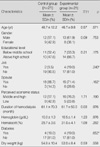Abstract
Purpose
The purpose of this study was to investigate the effect of stretching, muscle strengthening, and walking exercise on the cardiopulmonary function and health-related quality of life in hemodialysis patients.
Methods
Twenty-one patients in the intervention and the control group participated in the exercise respectively on maintenance hemodialysis at four university hospitals. The exercise was composed of 20 to 60 min per session, 3 sessions a week for 12 weeks. The effect of exercise was assessed by cardiopulmonary function (peak oxygen uptake, peak ventilation, peak respiration rate, maximal heart rate, and exercise duration) using a cycle ergometer. Grip strength was measured by dynamometer, and flexibility was measured by sit and reach measuring instrument. Health-related quality of life was measured using Medical Outcomes Study Short Form-36.
Figures and Tables
Table 1
Homogeneity Test for Demographic and Clinical Characteristics in the Control and Experimental Groups

Table 2
Homogeneity Test for Physical Fitness and Health-related Quality of Life in the Control and Experimental Groups

References
1. American College of Sports Medicine. ACSM's resource mannual for guides for exercise testing and prescription. 2001. 4th ed. Philadelphia, PA: Lippincott Williams & Wilkins.
2. DeOreo PB. Hemodialysis patient-assessed functional health status predicts continued survival, hospitalization, and dialysis-attendance compliance. American Journal of Kidney Disease. 1997. 30:204–212.
3. Diesel W, Novakes TD, Swanepoel C, Lambert M. Isokinetics muscle strength predicts maximal exercise tolerance in renal patients on chronic hemodialysis. American Journal of Kidney Disease. 1990. 16:109–114.
4. End Stage Renal Disease Registry Committee. Current renal replacement therapy in Korea -Insan memorial dialysis registry 2007-. Korean Journal of Nephrology. 2008. 27:Suppl. 2. 437–465.
5. Fuhrmann I, Krause R. Principles of exercising in patients with chronic kidney disease, on dialysis and for kidney transplant recipients. Journal of Clinical Nephrology. 2004. 61:Suppl. 1. 14–25.
6. Grumann MM, Noack EM, Hoffmann IA. Comparison of quality of life in patients undergoing abdominoperitoneal extirpation or anterior resection for rectal cancer. Annals of Surgery. 2001. 233:149–156.
7. Jun TW, Woo JH, Kim YS. Effect of basic military training on cardiopulmonary function of midshipmen. Journal of Korean Exercise Academy. 2000. 9:347–354.
8. Kim JS. The effect of exercise program on depression and anxiety in hemodialysis. 1997. Seoul: Korea University;Unpublished master's thesis.
9. Konstantinidou E, Koukouvou G, Kouidi E, Deligiannis A, Tourkantonis A. Exercise training in patients with end-stage renal disease on hemodialysis: Comparison of three rehabilitation programs. Journal of Rehabilitation Medicine. 2002. 34:40–45.
10. Kopple JD, Storer T, Casaburi R. Impaired exercise capacity and exercise training in maintenance on hemodialysis patients. Journal of Renal Nutrition. 2005. 15:44–48.
11. Kouidi E. Exercise training in dialysis patients: Why, when, and how? Artificial Organs. 2002. 26:1009–1013.
12. Kouidi E, Grekas D, Deligiannis A, Tourkantonis A. Outcomes of long-term exercise training in dialysis patients: Comparison of two training programs. Journal of Clinical Nephrology. 2004. 61:Suppl. 1. 31–38.
13. Lee SJ, Yoo JS. The effects of a physical activity reinforcement program on exercise compliance, depression, and anxiety in continuous ambulatory peritoneal dialysis patients. Journal of Korean Academy of Nursing. 2004. 34:440–448.
14. Lee YK, Kim C, Pyo JH, Kim CH, Ji JW. Endurance exercise training before hemodialysis: An effective therapeutic modality for end stage renal disease patients. Korean Journal of Nephrology. 2001. 20:290–297.
15. Moinuddin I, Leehey DJ. A comparison of aerobic exercise and resistance training in patients with and without chronic kidney disease. Advances in Chronic Kidney Disease. 2008. 15:83–96.
16. Molsted S, Eidemak I, Sorensen HT, Kristensen JH. Five months of physical exercise in hemodialysis patients: Effects on aerobic capacity, physical function and self-rated health. Nephron Clinical Practice. 2004. 96(3):76–81.
17. Oh SH, Yoo EK. Comparison of quality of life between kidney transplant and hemodialysis patients. Journal of Korean Academy of Nursing. 2006. 36:1145–1153.
18. Painter P, Carlson L, Carey S, Paul SM, Myll J. Low functioning hemodialysis patients improve with exercise training. American Journal of Kidney Disease. 2000. 36:600–608.
20. Painter P, Moore G, Carlson L, Paul S, Myll J, Phillips W, et al. Effects of exercise training plus normalization of hematocrit on exercise capacity and health-related quality of life. American Journal of Kidney Disease. 2002. 39:257–265.
20. Park OM, Fast S, Lynn R, Frei G, Drenth R, Zohman L. Exercise for the dialyzed: Aerobic and strength training during hemodialysis. American Journal of Physical Medicine & Rehabilitation. 2002. 81:814–821.
21. Shankar K. Exercise prescription. 1999. Philadelphia, PA: Hanley & Belfus Inc.
22. Sietsema KE, Hiatt WR, Enne E, Adler S, Amato A, Brass EP. Clinical and demographic predictors of exercise capacity in end-stage renal disease. American Journal of Kidney Disease. 2002. 39:76–85.
23. Suh MR, Jung HH, Kim SB, Park JS, Yang WS. Effects of regular exercise on anxiety, depression, and quality of life in maintenance hemodialysis patients. Renal Failure. 2002. 24:337–345.
24. The Life Options Rehabilitation Advisory Council. Exercise: A prescribing guide. 1995. Madison, WI: Amgen Inc.
25. The Life Options Rehabilitation Advisory Council. Exercise: A guide for the people on dialysis. 2000. Madison, WI: Amgen Inc.
26. The Society of Korean Language and Literature. Korean Language Dictionary. 2004. Seoul: Minjungeogwan.
27. Tsuyuki K, Kimura Y, Chiashi K, Matsushita C, Ninomiya K, Choh K, et al. Oxygen uptake efficiency slope as monitoring tool for physical training in chronic hemodialysis patients. Therapeutic Apheresis and Dialysis. 2003. 7:461–467.
28. Ware JE, Snow KK, Kosinski M, Gandek B. SF-36 health survey manual and interpretation guide. 1993. Boston, MA: New England Medical Center, The Health Institute.
29. Yang JS. A trial for development of health profile (KHP1.0) to measure the self-perceived health status of Korean. 2001. Gimhae: Inje University;Unpublished doctoral dissertation.
30. Yurtkuran M, Alp A, Yurtkuran M, Dilek K. A Modified yoga-based exercise program on hemodialysis patients: A randomized controlled study. Complementary Therapies in Medicine. 2007. 15:164–171.




 PDF
PDF ePub
ePub Citation
Citation Print
Print




 XML Download
XML Download